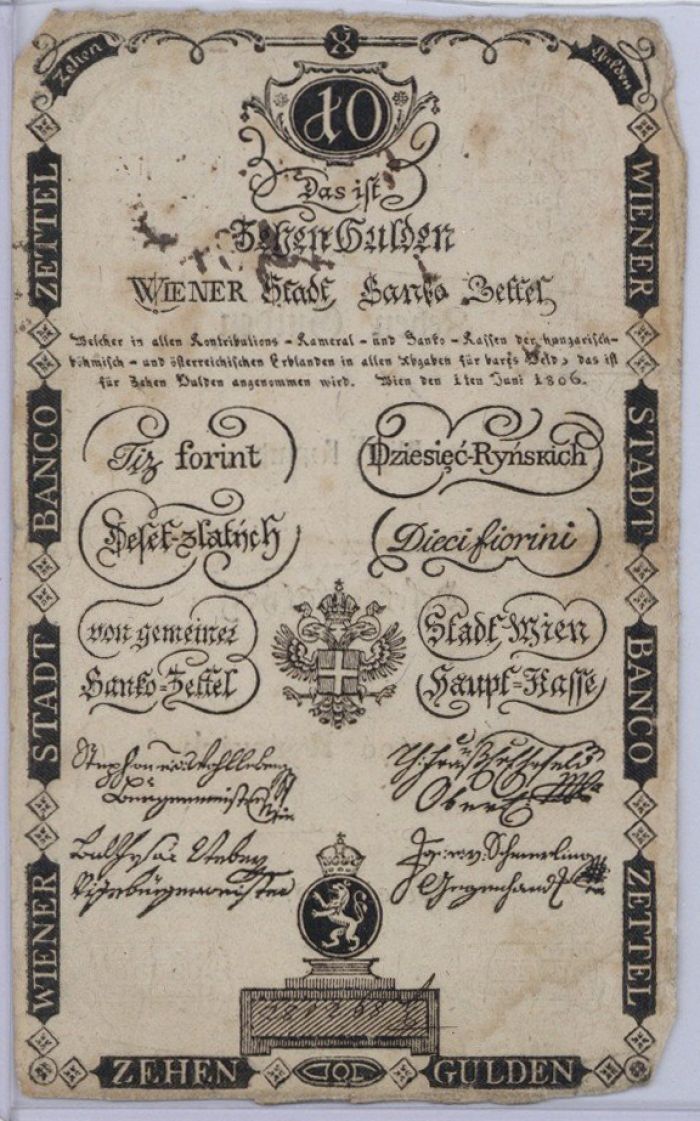Austria - P-A39a - Austro-Hungarian Gulden - Foreign Paper Money
Inv# FM2254 Foreign Paper Money
10 Golden, P-A39a. Printed on a heavy card stock.
The Gulden or forint (German: Gulden, Hungarian: forint, Croatian: forinta/florin, Czech: zlatý) was the currency of the lands of the House of Habsburg between 1754 and 1892 (known as the Austrian Empire from 1804 to 1867 and the Austro-Hungarian Monarchy after 1867), when it was replaced by the krone/korona as part of the introduction of the gold standard. In Austria, the Gulden was initially divided into 60 Kreuzer (Czech: krejcar), and in Hungary, the forint was divided into 60 krajczár (Croatian: krajcar). The currency was decimalized in 1857, using the same names for the unit and subunit.
The name Gulden was used on the pre-1867 Austrian banknotes and on the German language side of the post-1867 banknotes. In southern Germany, the word Gulden was the standard word for a major currency unit. The name Florin was used on Austrian coins and forint was used on the Hungarian language side of the post-1867 banknotes and on Hungarian coins. It comes from the city of Florence, Italy where the first florins were minted, from 1252 to 1533.
The Gulden first emerged as a common currency of the Holy Roman Empire after the 1524 Reichsmünzordnung in the form of the Guldengroschen. In the succeeding centuries the gulden was then defined as a fraction of the Reichsthaler specie or silver coin.
As of 1690 the gulden used in Southern Germany and the Austrian Empire adhered to the Leipzig standard, with the gulden worth 1/18th a Cologne Mark of fine silver or 1/2 the Reichsthaler specie coin, or 12.992 g per gulden. Below is a history (in terms of grams of silver) of the standards of the Austro-Hungarian Gulden from 1690 until the gold standard was introduced in 1892. A comparison with the lower-valued South German gulden is also included. The course of value of the gulden before 1618 is found under Reichsthaler.
The gulden departed from the Leipzig standard in the 1730s when the gold-silver price ratio dropped from 15 to 14.5, prompting several states to reissue their gulden in cheaper gold. The Austro-Hungarian gulden then departed from the South German gulden after it valued the Carolin d'or of 7.51 g fine gold at 9 Austrian Gulden, versus 11 Gulden in Southern Germany. This made the Austrian gulden worth 7.51/9 = 0.834 g fine gold or 0.834x14.5 = 12.1 g fine silver.
As Austria was the leading state of the Holy Roman Empire, it initiated the currency convention of 1754 in which the Conventionsthaler replaced the Reichsthaler specie as the standard currency of the Holy Roman Empire. The Gulden was defined as half of a Conventionsthaler, equivalent to 1⁄20 of a Cologne mark of silver, or 11.6928 g. The South German gulden was set lower at 24 Gulden per Cologne mark of silver, or 2.4 Gulden per Conventionsthaler, or 9.744 g. The North German Reichsthaler currency unit was then defined as 11⁄2 Gulden or 3⁄4 a Conventionsthaler, or 17.5392 g. Following the winding up of the Holy Roman Empire in 1806, the Gulden became the standard unit of account in the Habsburg lands and remained so until 1892. The gulden was subdivided in 60 kreuzer, each of 4 pfennig or 8 heller.
In 1857, the Vereinsthaler was introduced across the German Confederation and Austria-Hungary, with a silver content of 16+2⁄3 grams. This was slightly less than 1+1⁄2 times the silver content of the Gulden. Consequently, Austria-Hungary adopted a new standard for the Gulden, containing two-thirds as much silver as the Vereinsthaler, or 111⁄9 g. This involved a debasement of the currency of 4.97%. Austria-Hungary also decimalized at the same time, resulting in a new currency system of 100 Kreuzer (krajczár) = 1 Gulden (forint) and 1+1⁄2 Gulden = 1 Vereinsthaler.
In 1892 the Austro-Hungarian Gulden was replaced by the Krone, with each krone containing 100⁄328 gram gold, at a rate of 2 Krone (korona) = 1 Gulden (gold-silver ratio 18.2). In 1946 the Hungarian Forint (magyar forint) was re-introduced and remains the official currency in Hungary.










Ebay ID: labarre_galleries